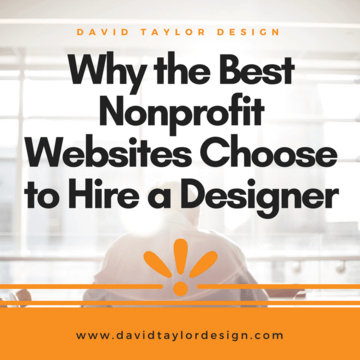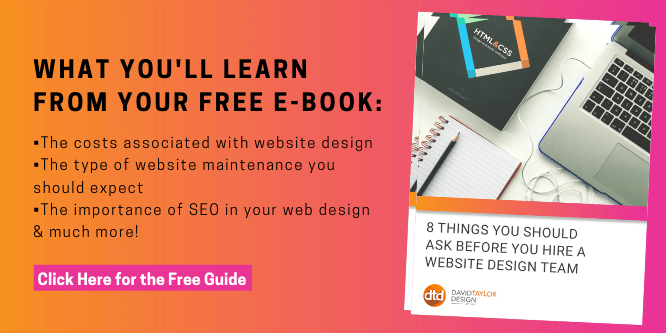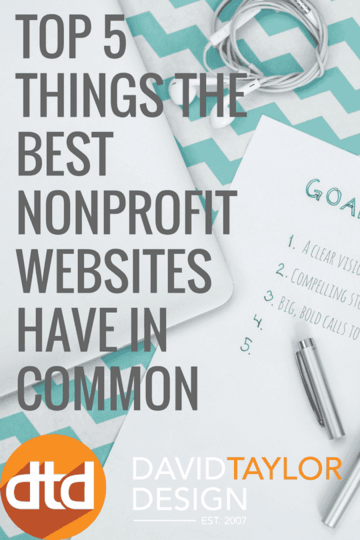
Navigating the digital landscape can be challenging, especially for nonprofits with limited resources. That’s why choosing the right web designer is crucial for creating the best nonprofit websites. These organizations often operate on tight budgets, making every marketing dollar count. A well-designed website isn’t just a luxury; it’s a necessity for reaching new audiences and boosting funding.
Nonprofit web design is a unique discipline that requires a specialized approach. The website must not only meet specific business objectives but also encapsulate the organization’s mission and values. Cutting corners isn’t an option. To truly make an impact and achieve long-term success, nonprofits need to invest in a web designer who understands their unique needs and can guide them toward their goals.
Here are some ways that professional web designers can help and why the best nonprofit websites chose to hire a designer:
Credibility
The notion of judging a book by its cover still stands true online. Professionally done websites give off the impression of reliability, trustworthiness, and expertise. It’s important for outsiders and potential investors to see a great-looking website because it shows legitimacy. A lot of grant-makers pass on less-noteworthy web presences in favor of those with more staying power and advanced layouts. Therefore, nonprofits shouldn’t underestimate the power of web designers.
Responsiveness
These days, users can access the internet almost anywhere and on any device such as tablets, mobile phones, and desktops. Keeping this in mind, a nonprofit’s website has to give the same user-friendly experience on each. Unfortunately, it’s not a one-size-fits-all situation. That’s where professional designers come in. They make sure sites can keep up with users of multiple devices by building fast and functional web pages. This also shows that an organization can keep up with the times.
An increase in traffic
Providing a positive experience for users across devices means an organization will likely see a boost in online traffic. Potential donors don’t last longer than a few seconds on a site if it doesn’t load properly. However, if they find themselves having a pleasurable experience, they will keep coming back for more. Plus, these users will likely spread the word around to their friends.
Brand growth
Though nonprofits might have other ways to market themselves, none compares to having a fantastic web presence. A professionally designed website is one of the best tools available when reaching new audiences throughout the world. Networking has never been easier, but its success depends on having a good web design.
Makes donating easier
Nonprofit websites should have built-in fundraising tools that make it quick and easy for people to donate. Having an accessible site that allows donors to find out more and enables them to donate by simply clicking a button can increase capital exponentially. This is especially true if an organization’s website is responsive on any device.
Social media
Good nonprofit websites should drive user engagement to their social media pages. These outlets are great for raising awareness, targeting donors, recruiting volunteers, and more. Designers can implement ways to track interactions so that organizations can see where their audiences thrive, making targeting easier.
Organizational tools
Web designers that specialize in nonprofits are invaluable when it comes to planning tools. Keeping audiences informed of upcoming events, donation tracking, and surveys through calendars, emails, and other handy tools are a great way to keep engagement. Professional designers might also know how to increase event participation to boost traffic and donations.
The power of a nonprofit’s strong, user-friendly website is limitless. That’s why investing and hiring a web designer is so crucial. A website might be the first touchpoint of a donor, which means it has to grab their attention and keep them interested. The best nonprofits know the value of a great website and hire designers to help them achieve their overall goals.
Hiring a professional web designer obviously has its benefits, especially for nonprofits. Having a website that not only stands out from the crowd but encourages your audience to participate with donations or volunteering is of utmost importance. Your entire marketing strategy could be improved or worse, depending on your nonprofit’s website.
Whether your marketing plan includes online advertising or offline approaches such as mail or TV advertising, people will want to find you online and likely end up on your website. A good website matters a great deal in any nonprofit marketing strategy—and in the same way, a bad website could hurt you. The quality of your website has a big impact on your marketing strategy’s success. To make sure every marketing dollar is spent wisely, it’s imperative to have a well-designed, up-to-date, and easily navigable website.
What are the three main reasons your website is crucial to your nonprofit marketing strategy?
Marketing won’t help your cause if website users can’t easily navigate your website.
In the age of the internet, people expect to be able to find information quickly and easily on any given website. It’s simple: People need to know what to do when they get to your website. If they can’t find their way around, the likelihood of any given user spending a lot of time navigating a confusing site to volunteer or give money is relatively low compared with a quick and easy website experience.
Many factors can affect your website visitors’ actions—including some factors that you might not think about. It’s not all about the message; it’s also about the technical and design elements of the site. For example, if visitors can’t easily navigate the site, they might not be able to find a place to take the desired action. Make sure you make it easy and clear—whether that’s creating a landing page for a specific donation push or big “VOLUNTEER” or “DONATE” buttons on your homepage.
Digital ad performance often depends on your website and landing page
If you’re using digital ads as a part of your marketing strategy, your website can make a big difference in how your ads perform. Search engines actually look through your landing page and website to determine digital ads’ performance based on numerous factors.
Advertising platforms want to make sure that users have the best experience possible with their ads, so they’re not likely to send their users to a poor website experience. Therefore, prioritize ads that link to sites they determine are good.
If your website is poorly built, not up to date, not mobile-friendly, slow to load, etc., your ads won’t do as well as they could—even if the ads themselves are perfect. Luckily, Google has countless tools that help you check up on your website and make sure you’re on track. If you’re not certain how your website is doing, take a look at their mobile-friendly test and PageSpeed Insights.
If your website is outdated or hard to navigate, your organization looks less trustworthy
Because websites have become so commonplace, easy to make, and simple to update (not just for developers!), internet users always expect an up-to-date, modern website. Outdated websites or websites that are difficult to navigate will raise suspicion for most users.
If your website visitors can’t find updated information on what you do or who you are, they likely won’t fully trust your organization. For example, if your mission, what you do, and/or contact information aren’t readily available and easy to find online, website visitors will hesitate to get involved—especially if you’re asking them to donate. Even if your marketing plan is great, directing people to a bad or outdated website could lead to a big drop-off in membership, donations, volunteers, or whatever it is you’re driving people to do.
Now you should understand why having a good website for your nonprofit is so important. So, let’s discuss some tips for designing a great website and optimizing your messaging so you get users to your nonprofit website and keep them around to learn more about you.
If your organization intends to build a website, chances are you will need professional assistance when it comes to developing a design that best fits your nonprofit. One thing many organizations don’t realize is that your website is an extension of your company, and it intensely affects the way people will view your organization. How you present the information, the clarity of your focus and the design choices you make will heavily influence the way people understand and even interact with your content.
Most importantly, your website design is the first impression a person has on your company and its mission. It will also influence whether visitors ultimately decide to become donors or make a one-time contribution.
Top Tips for Designing the Best Nonprofit Website & How to Optimize Your Messaging
In the digital age, having a strong online presence is essential for any organization, especially nonprofits. A well-designed website coupled with optimized messaging can be a game-changer in achieving your mission and fundraising goals. Here are some top tips to help you create one of the best nonprofit websites and optimize your messaging:
Know Your Audience
Understanding your target audience is the first step in creating a website that resonates. Whether you’re reaching out to young activists or seasoned philanthropists, your content and design should be tailored to engage them effectively. By knowing your audience, you can offer not just a vision of what your organization can achieve, but also what it can provide to those who support it.
Brand Identity
Your brand identity is the soul of your nonprofit. It should be immediately evident through the visuals and content on your website. This is crucial for building trust and encouraging donations. A well-defined brand identity can serve as a powerful introduction to the deeper values and missions of your organization.
Mission Statement/Content
The mission statement is the heart of your nonprofit and should be prominently displayed on your website. Given the short attention span of online users, it’s crucial to make your mission clear and compelling within the first few seconds of their visit. Use visuals and testimonials to support your mission and provide a snapshot of your organization’s impact.
Mobile Responsive
In today’s world, mobile responsiveness isn’t a luxury; it’s a necessity. Ensure that your website is easily navigable on all devices to reach a broader audience. Features like digital wallets can simplify the donation process and potentially increase contributions, aligning with your nonprofit fundraising strategic plan.
Subscription and Donation Boxes
Email newsletters are an invaluable tool for maintaining ongoing communication with your audience. Make sure to feature subscription and donation boxes prominently on your website. Provide a brief description to let visitors know what they can expect when they subscribe, whether it’s updates, success stories, or upcoming events.
Optimizing Your Nonprofit Messaging
Effective messaging is the cornerstone of any successful nonprofit. But how do you ensure that your message not only reaches but also resonates with your target audience? Here are some steps to optimize your nonprofit messaging:
Step 1: Define Your Mission
A clear and concise mission statement is the foundation of your nonprofit. Consider breaking down your mission and long-term goals into bullet points for easy readability. This allows potential donors to quickly understand what your organization aims to achieve.
Step 2: Appeal to Your Audience
Tailoring your message to resonate with your target audience is crucial. Show them the good that their donations can achieve and how supporting your cause aligns with their own values or community needs.
Step 3: Make Your Mission Easy to Remember
A memorable mission statement can significantly impact your nonprofit’s success. Aim for a mission statement that is as concise and memorable as possible, making it easier for potential donors to recall your organization and its goals.
Step 4: Identify Where Your Organization’s Services and Your Audience’s Needs Overlap
Show potential donors how your services align with their values or needs. This not only strengthens your message but also makes it more compelling for potential donors.
Step 5: Utilization of Brand Ambassadors
Brand ambassadors can significantly amplify your message and extend your reach. Whether it’s a local influencer or a dedicated volunteer, these individuals can be invaluable assets in your nonprofit fundraising strategic plan.
By following these tips and optimizing your messaging, you can stand out in a crowded nonprofit landscape. Remember, the key to a successful nonprofit is not just what donors can do for you, but what you can achieve with their support.
Conclusion
Choosing the right web designer for your nonprofit is a critical decision that can significantly impact your organization’s online presence and fundraising capabilities. From understanding your audience to establishing a strong brand identity, the elements that go into creating one of the best nonprofit websites are numerous and nuanced. But with the right guidance and expertise, you can create a website that not only looks great, but also effectively communicates your mission and engages your audience.
Ready to take your nonprofit’s online presence to the next level?
At David Taylor Digital, we specialize in crafting bespoke web solutions that amplify your message and drive engagement. If you have any questions or would like to speak with one of our professionals about nonprofit web design, don’t hesitate to contact us today. Let’s work together to make your vision a reality.

